Exploring the Correlation: Drug Abuse and HIV/AIDS Transmission
VerifiedAdded on 2023/06/04
|8
|1935
|327
Report
AI Summary
This report explores the intricate relationship between drug abuse and the spread of HIV/AIDS, focusing on barriers to treatment access, challenges faced by people living with HIV, and the stigmas surrounding ARV drugs. It investigates the impact of treatment accessibility on HIV/AIDS patients and the influence of cultural factors on treatment perception. The research aims to contribute to the field by challenging existing knowledge, uncovering new information, and informing the reasons behind low VCT center visits and increased HIV/AIDS cases among youth. Theoretical frameworks such as the expectancy theory are used to explain how drug abuse influences sexual behaviors and HIV risk. The research design involves primary data collection through questionnaires targeting both general populations and individuals living with HIV/AIDS and drug users, supplemented by secondary data from government ministries, hospitals, and peer-reviewed articles. Ethical considerations, including informed consent, are addressed to ensure participant rights and confidentiality. The study acknowledges limitations, such as the reliance on questionnaires, and emphasizes the need for complementary research methods. Desklib provides access to this and other student-contributed assignments.
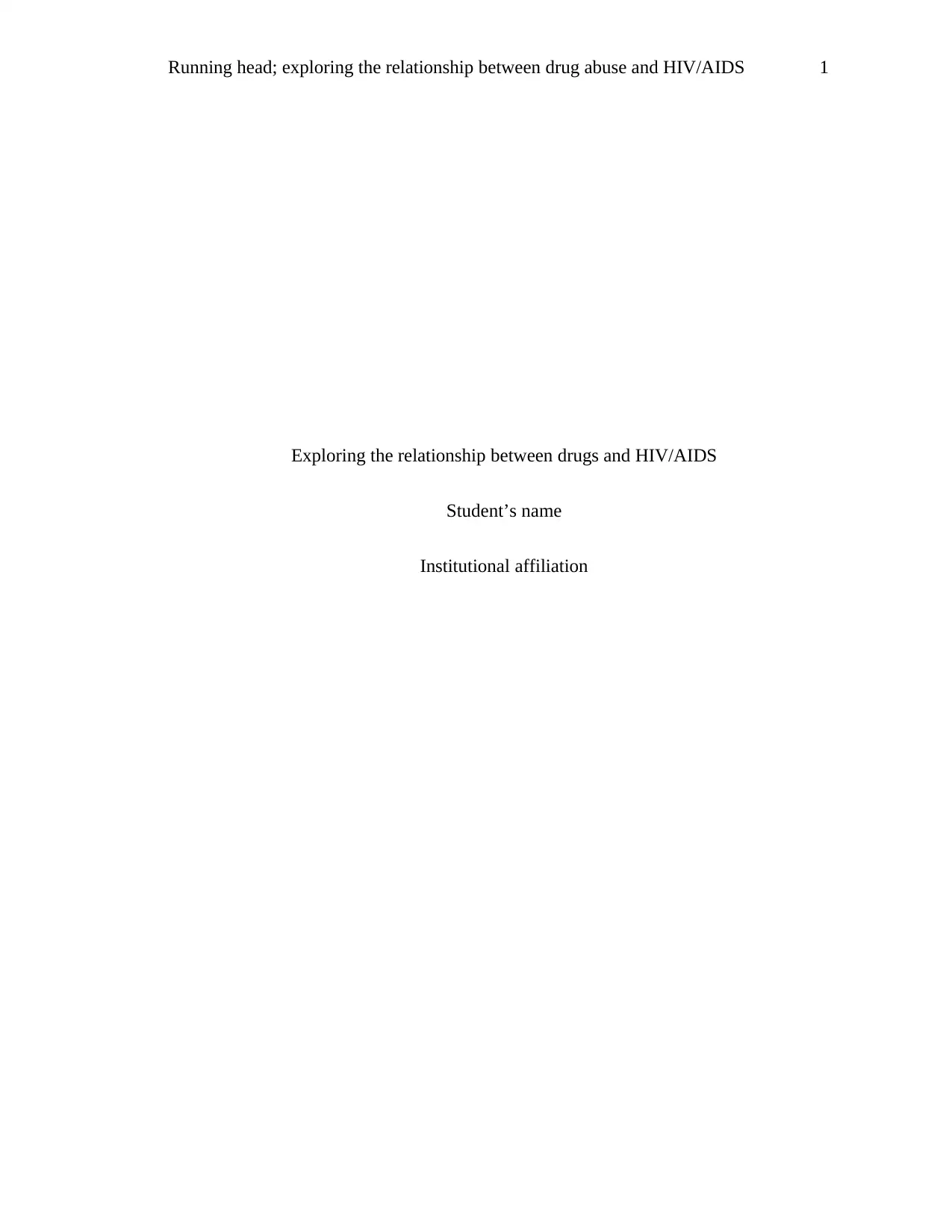
Running head; exploring the relationship between drug abuse and HIV/AIDS 1
Exploring the relationship between drugs and HIV/AIDS
Student’s name
Institutional affiliation
Exploring the relationship between drugs and HIV/AIDS
Student’s name
Institutional affiliation
Paraphrase This Document
Need a fresh take? Get an instant paraphrase of this document with our AI Paraphraser
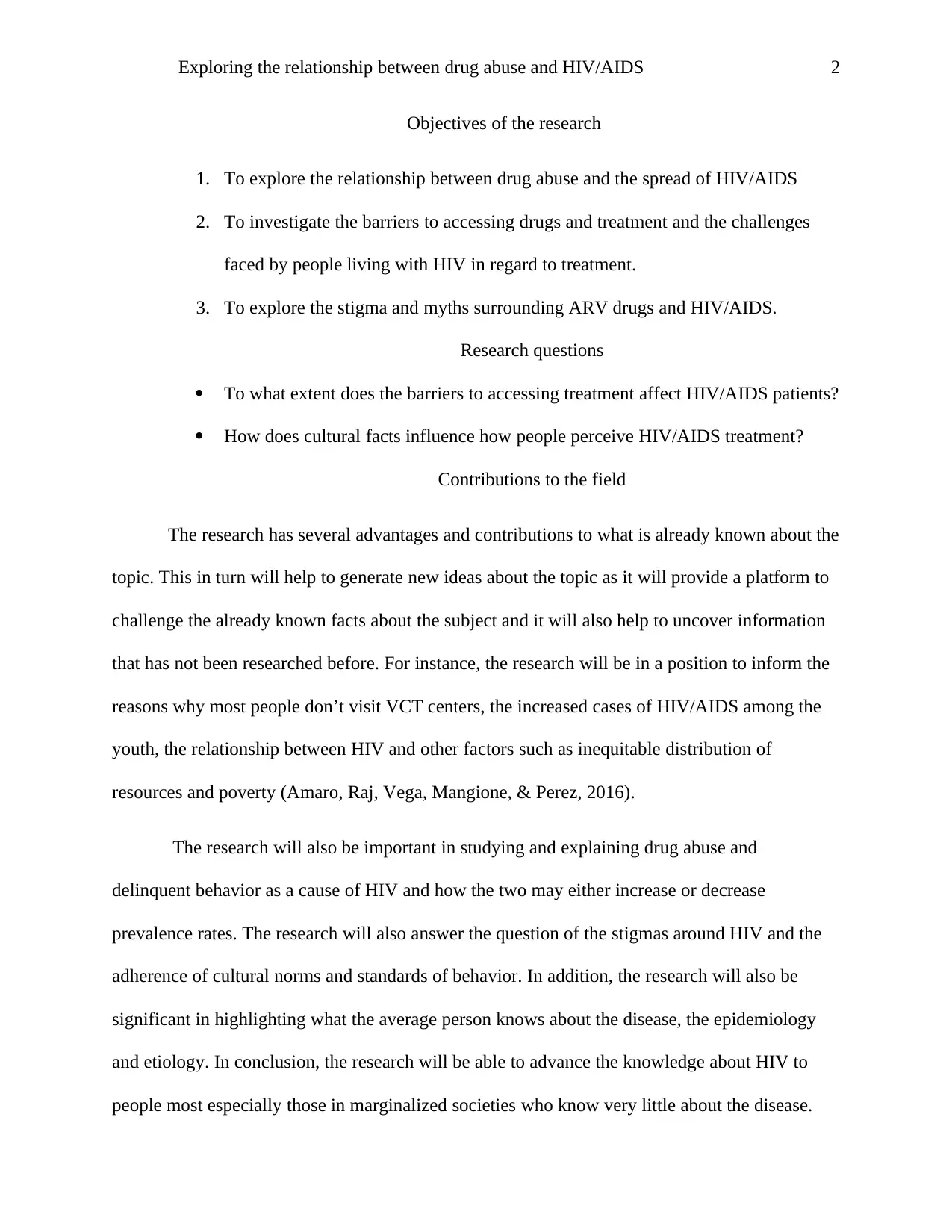
Exploring the relationship between drug abuse and HIV/AIDS 2
Objectives of the research
1. To explore the relationship between drug abuse and the spread of HIV/AIDS
2. To investigate the barriers to accessing drugs and treatment and the challenges
faced by people living with HIV in regard to treatment.
3. To explore the stigma and myths surrounding ARV drugs and HIV/AIDS.
Research questions
To what extent does the barriers to accessing treatment affect HIV/AIDS patients?
How does cultural facts influence how people perceive HIV/AIDS treatment?
Contributions to the field
The research has several advantages and contributions to what is already known about the
topic. This in turn will help to generate new ideas about the topic as it will provide a platform to
challenge the already known facts about the subject and it will also help to uncover information
that has not been researched before. For instance, the research will be in a position to inform the
reasons why most people don’t visit VCT centers, the increased cases of HIV/AIDS among the
youth, the relationship between HIV and other factors such as inequitable distribution of
resources and poverty (Amaro, Raj, Vega, Mangione, & Perez, 2016).
The research will also be important in studying and explaining drug abuse and
delinquent behavior as a cause of HIV and how the two may either increase or decrease
prevalence rates. The research will also answer the question of the stigmas around HIV and the
adherence of cultural norms and standards of behavior. In addition, the research will also be
significant in highlighting what the average person knows about the disease, the epidemiology
and etiology. In conclusion, the research will be able to advance the knowledge about HIV to
people most especially those in marginalized societies who know very little about the disease.
Objectives of the research
1. To explore the relationship between drug abuse and the spread of HIV/AIDS
2. To investigate the barriers to accessing drugs and treatment and the challenges
faced by people living with HIV in regard to treatment.
3. To explore the stigma and myths surrounding ARV drugs and HIV/AIDS.
Research questions
To what extent does the barriers to accessing treatment affect HIV/AIDS patients?
How does cultural facts influence how people perceive HIV/AIDS treatment?
Contributions to the field
The research has several advantages and contributions to what is already known about the
topic. This in turn will help to generate new ideas about the topic as it will provide a platform to
challenge the already known facts about the subject and it will also help to uncover information
that has not been researched before. For instance, the research will be in a position to inform the
reasons why most people don’t visit VCT centers, the increased cases of HIV/AIDS among the
youth, the relationship between HIV and other factors such as inequitable distribution of
resources and poverty (Amaro, Raj, Vega, Mangione, & Perez, 2016).
The research will also be important in studying and explaining drug abuse and
delinquent behavior as a cause of HIV and how the two may either increase or decrease
prevalence rates. The research will also answer the question of the stigmas around HIV and the
adherence of cultural norms and standards of behavior. In addition, the research will also be
significant in highlighting what the average person knows about the disease, the epidemiology
and etiology. In conclusion, the research will be able to advance the knowledge about HIV to
people most especially those in marginalized societies who know very little about the disease.
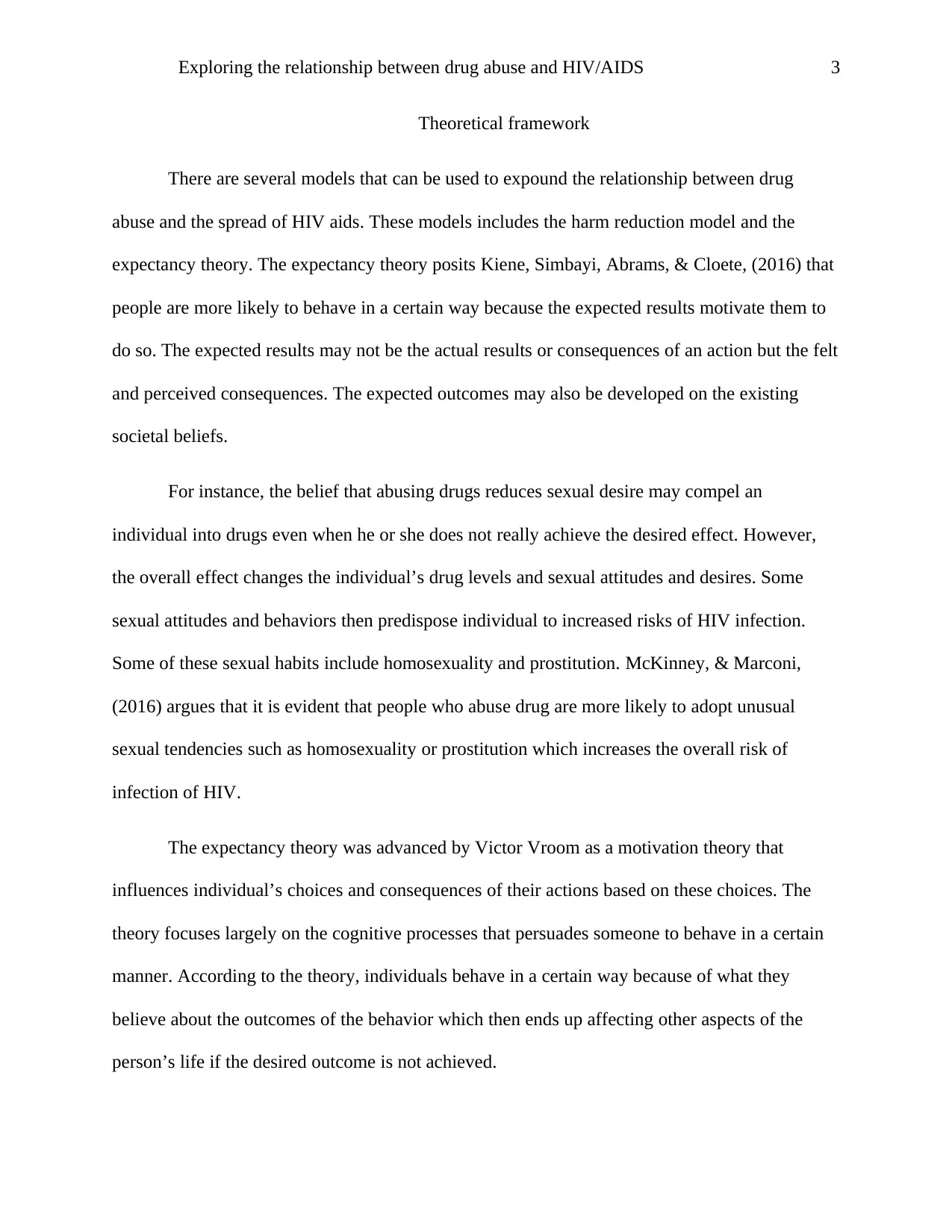
Exploring the relationship between drug abuse and HIV/AIDS 3
Theoretical framework
There are several models that can be used to expound the relationship between drug
abuse and the spread of HIV aids. These models includes the harm reduction model and the
expectancy theory. The expectancy theory posits Kiene, Simbayi, Abrams, & Cloete, (2016) that
people are more likely to behave in a certain way because the expected results motivate them to
do so. The expected results may not be the actual results or consequences of an action but the felt
and perceived consequences. The expected outcomes may also be developed on the existing
societal beliefs.
For instance, the belief that abusing drugs reduces sexual desire may compel an
individual into drugs even when he or she does not really achieve the desired effect. However,
the overall effect changes the individual’s drug levels and sexual attitudes and desires. Some
sexual attitudes and behaviors then predispose individual to increased risks of HIV infection.
Some of these sexual habits include homosexuality and prostitution. McKinney, & Marconi,
(2016) argues that it is evident that people who abuse drug are more likely to adopt unusual
sexual tendencies such as homosexuality or prostitution which increases the overall risk of
infection of HIV.
The expectancy theory was advanced by Victor Vroom as a motivation theory that
influences individual’s choices and consequences of their actions based on these choices. The
theory focuses largely on the cognitive processes that persuades someone to behave in a certain
manner. According to the theory, individuals behave in a certain way because of what they
believe about the outcomes of the behavior which then ends up affecting other aspects of the
person’s life if the desired outcome is not achieved.
Theoretical framework
There are several models that can be used to expound the relationship between drug
abuse and the spread of HIV aids. These models includes the harm reduction model and the
expectancy theory. The expectancy theory posits Kiene, Simbayi, Abrams, & Cloete, (2016) that
people are more likely to behave in a certain way because the expected results motivate them to
do so. The expected results may not be the actual results or consequences of an action but the felt
and perceived consequences. The expected outcomes may also be developed on the existing
societal beliefs.
For instance, the belief that abusing drugs reduces sexual desire may compel an
individual into drugs even when he or she does not really achieve the desired effect. However,
the overall effect changes the individual’s drug levels and sexual attitudes and desires. Some
sexual attitudes and behaviors then predispose individual to increased risks of HIV infection.
Some of these sexual habits include homosexuality and prostitution. McKinney, & Marconi,
(2016) argues that it is evident that people who abuse drug are more likely to adopt unusual
sexual tendencies such as homosexuality or prostitution which increases the overall risk of
infection of HIV.
The expectancy theory was advanced by Victor Vroom as a motivation theory that
influences individual’s choices and consequences of their actions based on these choices. The
theory focuses largely on the cognitive processes that persuades someone to behave in a certain
manner. According to the theory, individuals behave in a certain way because of what they
believe about the outcomes of the behavior which then ends up affecting other aspects of the
person’s life if the desired outcome is not achieved.
⊘ This is a preview!⊘
Do you want full access?
Subscribe today to unlock all pages.

Trusted by 1+ million students worldwide
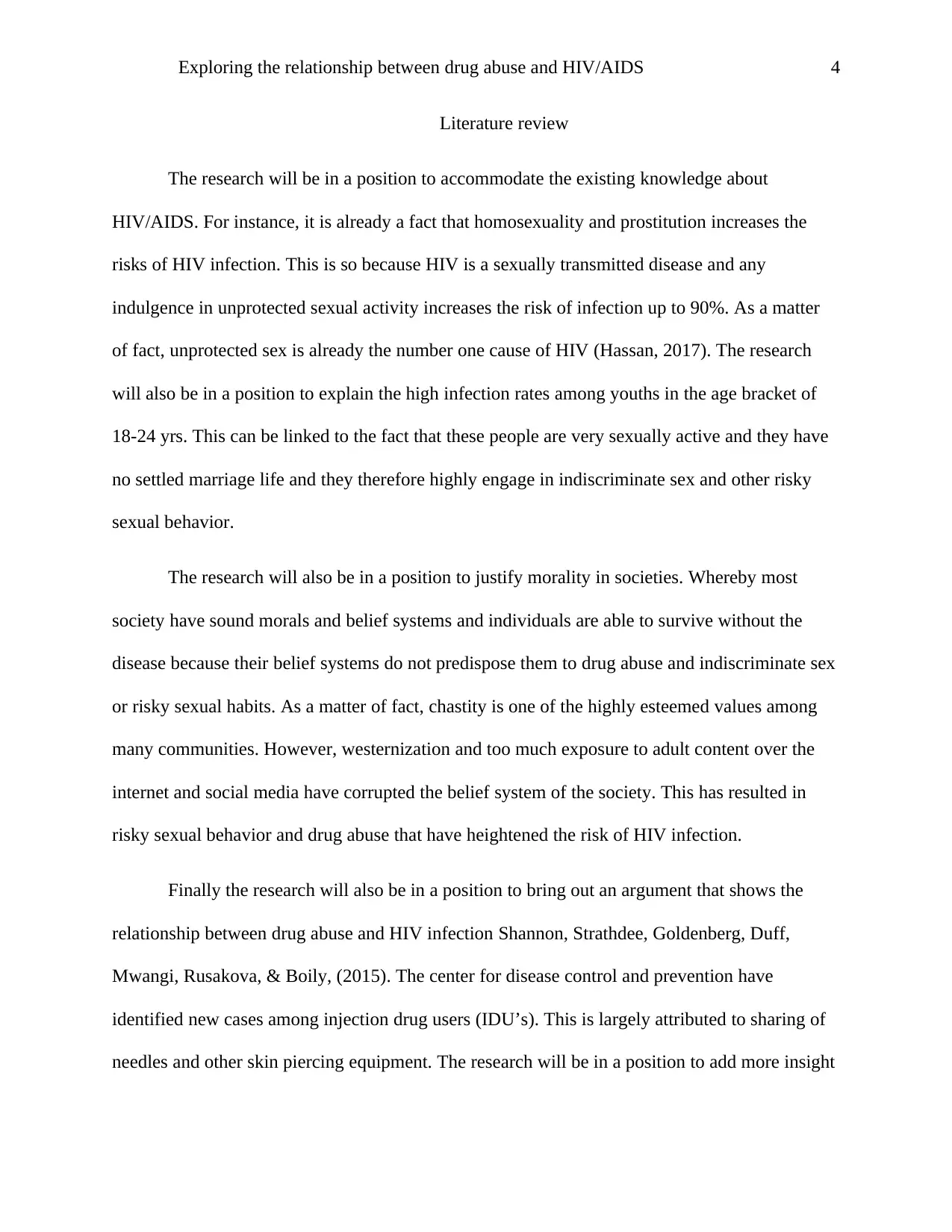
Exploring the relationship between drug abuse and HIV/AIDS 4
Literature review
The research will be in a position to accommodate the existing knowledge about
HIV/AIDS. For instance, it is already a fact that homosexuality and prostitution increases the
risks of HIV infection. This is so because HIV is a sexually transmitted disease and any
indulgence in unprotected sexual activity increases the risk of infection up to 90%. As a matter
of fact, unprotected sex is already the number one cause of HIV (Hassan, 2017). The research
will also be in a position to explain the high infection rates among youths in the age bracket of
18-24 yrs. This can be linked to the fact that these people are very sexually active and they have
no settled marriage life and they therefore highly engage in indiscriminate sex and other risky
sexual behavior.
The research will also be in a position to justify morality in societies. Whereby most
society have sound morals and belief systems and individuals are able to survive without the
disease because their belief systems do not predispose them to drug abuse and indiscriminate sex
or risky sexual habits. As a matter of fact, chastity is one of the highly esteemed values among
many communities. However, westernization and too much exposure to adult content over the
internet and social media have corrupted the belief system of the society. This has resulted in
risky sexual behavior and drug abuse that have heightened the risk of HIV infection.
Finally the research will also be in a position to bring out an argument that shows the
relationship between drug abuse and HIV infection Shannon, Strathdee, Goldenberg, Duff,
Mwangi, Rusakova, & Boily, (2015). The center for disease control and prevention have
identified new cases among injection drug users (IDU’s). This is largely attributed to sharing of
needles and other skin piercing equipment. The research will be in a position to add more insight
Literature review
The research will be in a position to accommodate the existing knowledge about
HIV/AIDS. For instance, it is already a fact that homosexuality and prostitution increases the
risks of HIV infection. This is so because HIV is a sexually transmitted disease and any
indulgence in unprotected sexual activity increases the risk of infection up to 90%. As a matter
of fact, unprotected sex is already the number one cause of HIV (Hassan, 2017). The research
will also be in a position to explain the high infection rates among youths in the age bracket of
18-24 yrs. This can be linked to the fact that these people are very sexually active and they have
no settled marriage life and they therefore highly engage in indiscriminate sex and other risky
sexual behavior.
The research will also be in a position to justify morality in societies. Whereby most
society have sound morals and belief systems and individuals are able to survive without the
disease because their belief systems do not predispose them to drug abuse and indiscriminate sex
or risky sexual habits. As a matter of fact, chastity is one of the highly esteemed values among
many communities. However, westernization and too much exposure to adult content over the
internet and social media have corrupted the belief system of the society. This has resulted in
risky sexual behavior and drug abuse that have heightened the risk of HIV infection.
Finally the research will also be in a position to bring out an argument that shows the
relationship between drug abuse and HIV infection Shannon, Strathdee, Goldenberg, Duff,
Mwangi, Rusakova, & Boily, (2015). The center for disease control and prevention have
identified new cases among injection drug users (IDU’s). This is largely attributed to sharing of
needles and other skin piercing equipment. The research will be in a position to add more insight
Paraphrase This Document
Need a fresh take? Get an instant paraphrase of this document with our AI Paraphraser
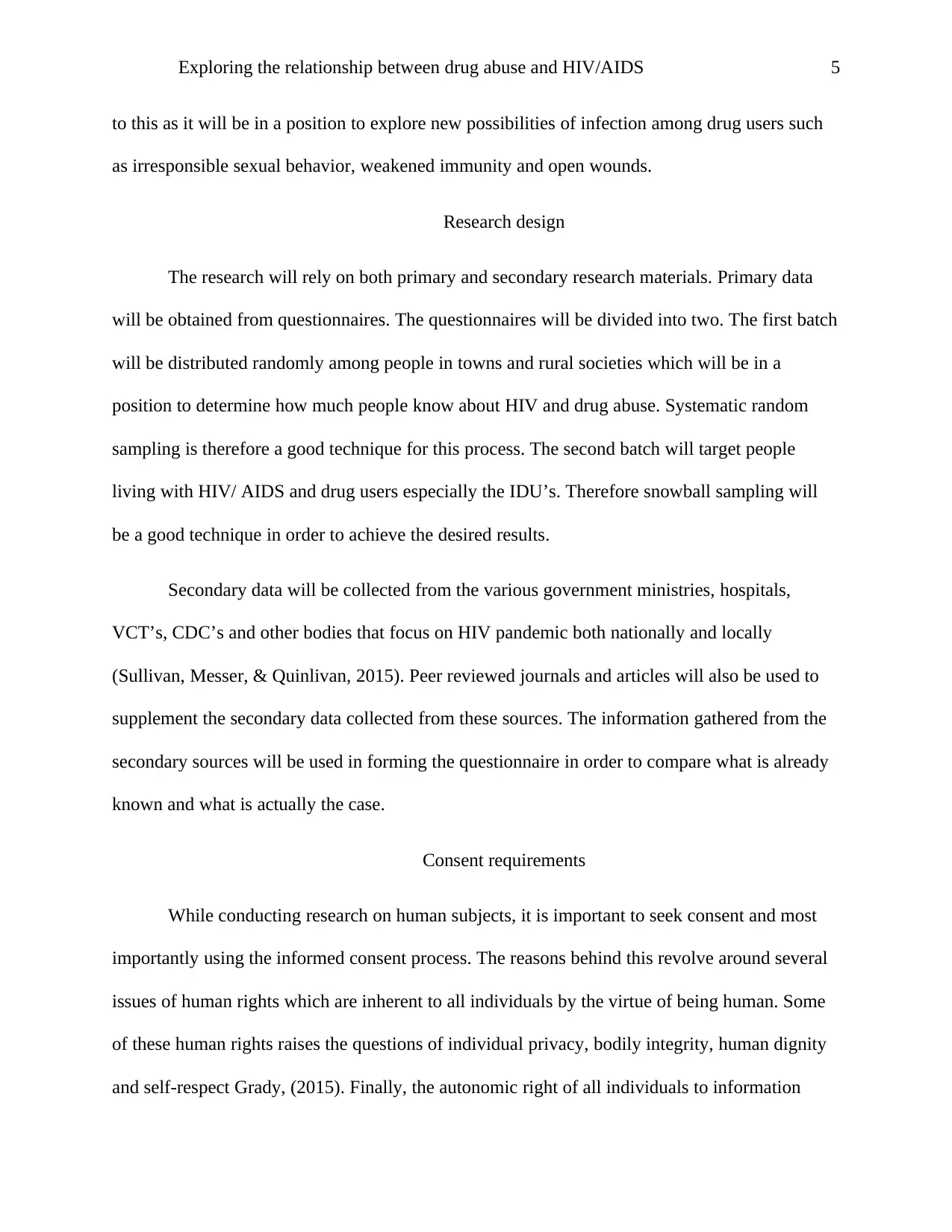
Exploring the relationship between drug abuse and HIV/AIDS 5
to this as it will be in a position to explore new possibilities of infection among drug users such
as irresponsible sexual behavior, weakened immunity and open wounds.
Research design
The research will rely on both primary and secondary research materials. Primary data
will be obtained from questionnaires. The questionnaires will be divided into two. The first batch
will be distributed randomly among people in towns and rural societies which will be in a
position to determine how much people know about HIV and drug abuse. Systematic random
sampling is therefore a good technique for this process. The second batch will target people
living with HIV/ AIDS and drug users especially the IDU’s. Therefore snowball sampling will
be a good technique in order to achieve the desired results.
Secondary data will be collected from the various government ministries, hospitals,
VCT’s, CDC’s and other bodies that focus on HIV pandemic both nationally and locally
(Sullivan, Messer, & Quinlivan, 2015). Peer reviewed journals and articles will also be used to
supplement the secondary data collected from these sources. The information gathered from the
secondary sources will be used in forming the questionnaire in order to compare what is already
known and what is actually the case.
Consent requirements
While conducting research on human subjects, it is important to seek consent and most
importantly using the informed consent process. The reasons behind this revolve around several
issues of human rights which are inherent to all individuals by the virtue of being human. Some
of these human rights raises the questions of individual privacy, bodily integrity, human dignity
and self-respect Grady, (2015). Finally, the autonomic right of all individuals to information
to this as it will be in a position to explore new possibilities of infection among drug users such
as irresponsible sexual behavior, weakened immunity and open wounds.
Research design
The research will rely on both primary and secondary research materials. Primary data
will be obtained from questionnaires. The questionnaires will be divided into two. The first batch
will be distributed randomly among people in towns and rural societies which will be in a
position to determine how much people know about HIV and drug abuse. Systematic random
sampling is therefore a good technique for this process. The second batch will target people
living with HIV/ AIDS and drug users especially the IDU’s. Therefore snowball sampling will
be a good technique in order to achieve the desired results.
Secondary data will be collected from the various government ministries, hospitals,
VCT’s, CDC’s and other bodies that focus on HIV pandemic both nationally and locally
(Sullivan, Messer, & Quinlivan, 2015). Peer reviewed journals and articles will also be used to
supplement the secondary data collected from these sources. The information gathered from the
secondary sources will be used in forming the questionnaire in order to compare what is already
known and what is actually the case.
Consent requirements
While conducting research on human subjects, it is important to seek consent and most
importantly using the informed consent process. The reasons behind this revolve around several
issues of human rights which are inherent to all individuals by the virtue of being human. Some
of these human rights raises the questions of individual privacy, bodily integrity, human dignity
and self-respect Grady, (2015). Finally, the autonomic right of all individuals to information
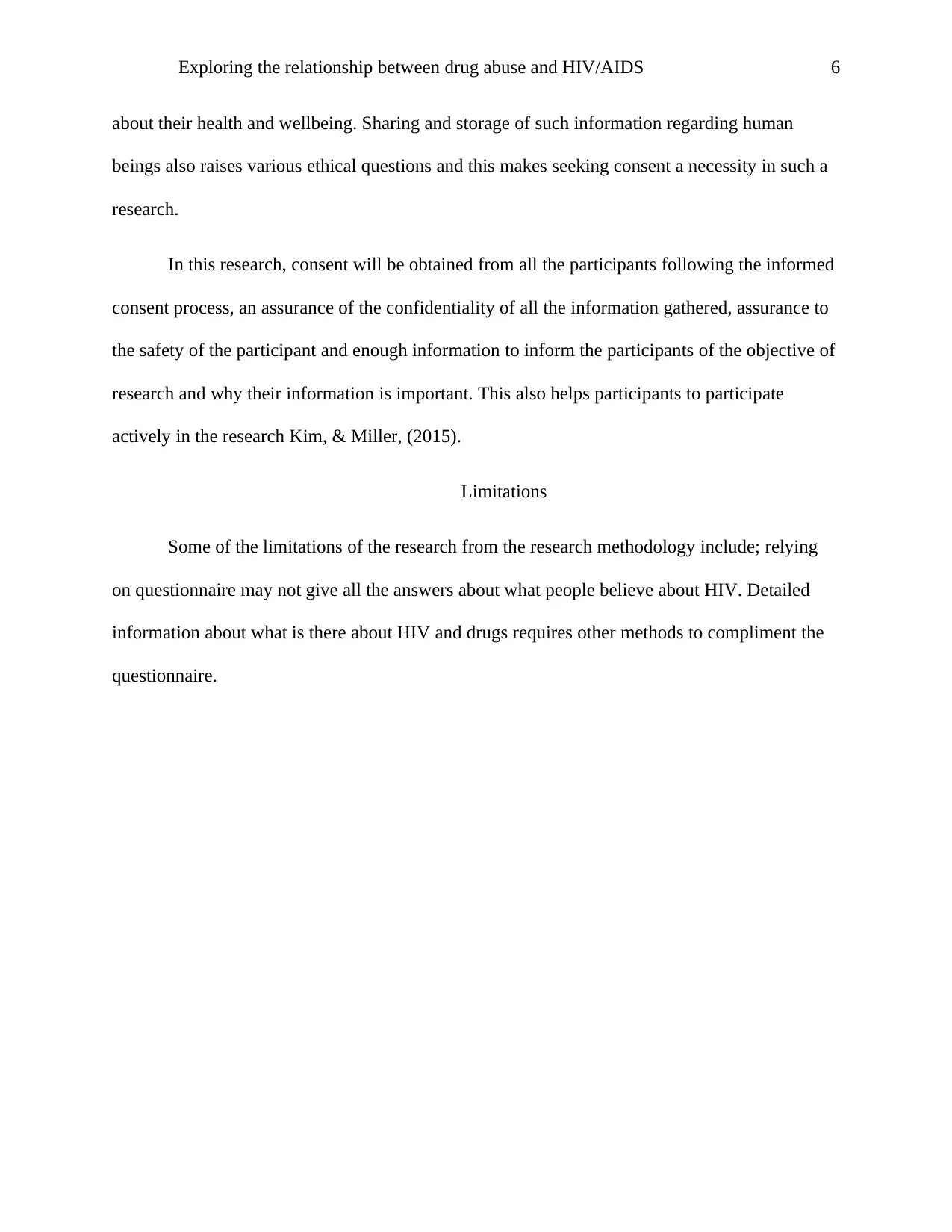
Exploring the relationship between drug abuse and HIV/AIDS 6
about their health and wellbeing. Sharing and storage of such information regarding human
beings also raises various ethical questions and this makes seeking consent a necessity in such a
research.
In this research, consent will be obtained from all the participants following the informed
consent process, an assurance of the confidentiality of all the information gathered, assurance to
the safety of the participant and enough information to inform the participants of the objective of
research and why their information is important. This also helps participants to participate
actively in the research Kim, & Miller, (2015).
Limitations
Some of the limitations of the research from the research methodology include; relying
on questionnaire may not give all the answers about what people believe about HIV. Detailed
information about what is there about HIV and drugs requires other methods to compliment the
questionnaire.
about their health and wellbeing. Sharing and storage of such information regarding human
beings also raises various ethical questions and this makes seeking consent a necessity in such a
research.
In this research, consent will be obtained from all the participants following the informed
consent process, an assurance of the confidentiality of all the information gathered, assurance to
the safety of the participant and enough information to inform the participants of the objective of
research and why their information is important. This also helps participants to participate
actively in the research Kim, & Miller, (2015).
Limitations
Some of the limitations of the research from the research methodology include; relying
on questionnaire may not give all the answers about what people believe about HIV. Detailed
information about what is there about HIV and drugs requires other methods to compliment the
questionnaire.
⊘ This is a preview!⊘
Do you want full access?
Subscribe today to unlock all pages.

Trusted by 1+ million students worldwide
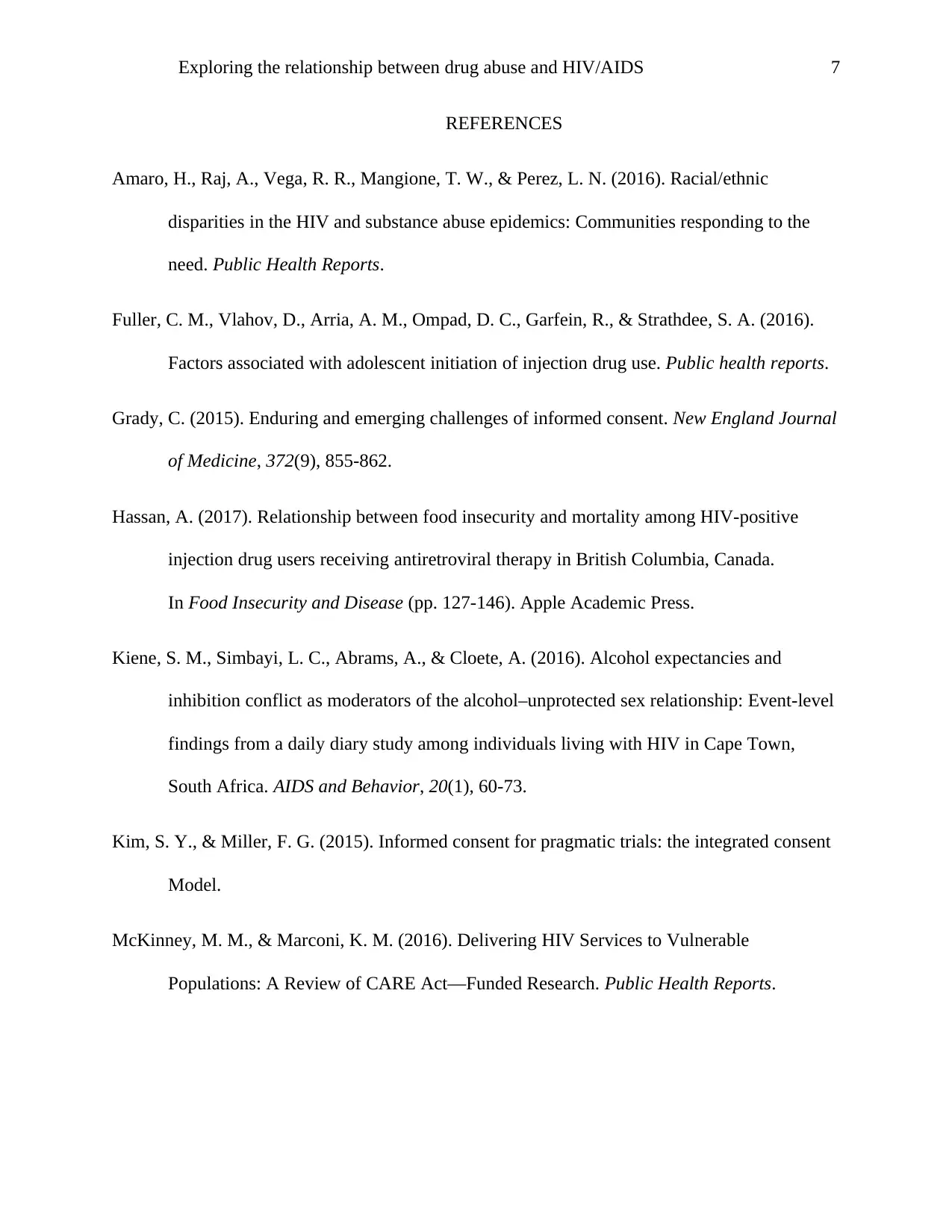
Exploring the relationship between drug abuse and HIV/AIDS 7
REFERENCES
Amaro, H., Raj, A., Vega, R. R., Mangione, T. W., & Perez, L. N. (2016). Racial/ethnic
disparities in the HIV and substance abuse epidemics: Communities responding to the
need. Public Health Reports.
Fuller, C. M., Vlahov, D., Arria, A. M., Ompad, D. C., Garfein, R., & Strathdee, S. A. (2016).
Factors associated with adolescent initiation of injection drug use. Public health reports.
Grady, C. (2015). Enduring and emerging challenges of informed consent. New England Journal
of Medicine, 372(9), 855-862.
Hassan, A. (2017). Relationship between food insecurity and mortality among HIV-positive
injection drug users receiving antiretroviral therapy in British Columbia, Canada.
In Food Insecurity and Disease (pp. 127-146). Apple Academic Press.
Kiene, S. M., Simbayi, L. C., Abrams, A., & Cloete, A. (2016). Alcohol expectancies and
inhibition conflict as moderators of the alcohol–unprotected sex relationship: Event-level
findings from a daily diary study among individuals living with HIV in Cape Town,
South Africa. AIDS and Behavior, 20(1), 60-73.
Kim, S. Y., & Miller, F. G. (2015). Informed consent for pragmatic trials: the integrated consent
Model.
McKinney, M. M., & Marconi, K. M. (2016). Delivering HIV Services to Vulnerable
Populations: A Review of CARE Act—Funded Research. Public Health Reports.
REFERENCES
Amaro, H., Raj, A., Vega, R. R., Mangione, T. W., & Perez, L. N. (2016). Racial/ethnic
disparities in the HIV and substance abuse epidemics: Communities responding to the
need. Public Health Reports.
Fuller, C. M., Vlahov, D., Arria, A. M., Ompad, D. C., Garfein, R., & Strathdee, S. A. (2016).
Factors associated with adolescent initiation of injection drug use. Public health reports.
Grady, C. (2015). Enduring and emerging challenges of informed consent. New England Journal
of Medicine, 372(9), 855-862.
Hassan, A. (2017). Relationship between food insecurity and mortality among HIV-positive
injection drug users receiving antiretroviral therapy in British Columbia, Canada.
In Food Insecurity and Disease (pp. 127-146). Apple Academic Press.
Kiene, S. M., Simbayi, L. C., Abrams, A., & Cloete, A. (2016). Alcohol expectancies and
inhibition conflict as moderators of the alcohol–unprotected sex relationship: Event-level
findings from a daily diary study among individuals living with HIV in Cape Town,
South Africa. AIDS and Behavior, 20(1), 60-73.
Kim, S. Y., & Miller, F. G. (2015). Informed consent for pragmatic trials: the integrated consent
Model.
McKinney, M. M., & Marconi, K. M. (2016). Delivering HIV Services to Vulnerable
Populations: A Review of CARE Act—Funded Research. Public Health Reports.
Paraphrase This Document
Need a fresh take? Get an instant paraphrase of this document with our AI Paraphraser
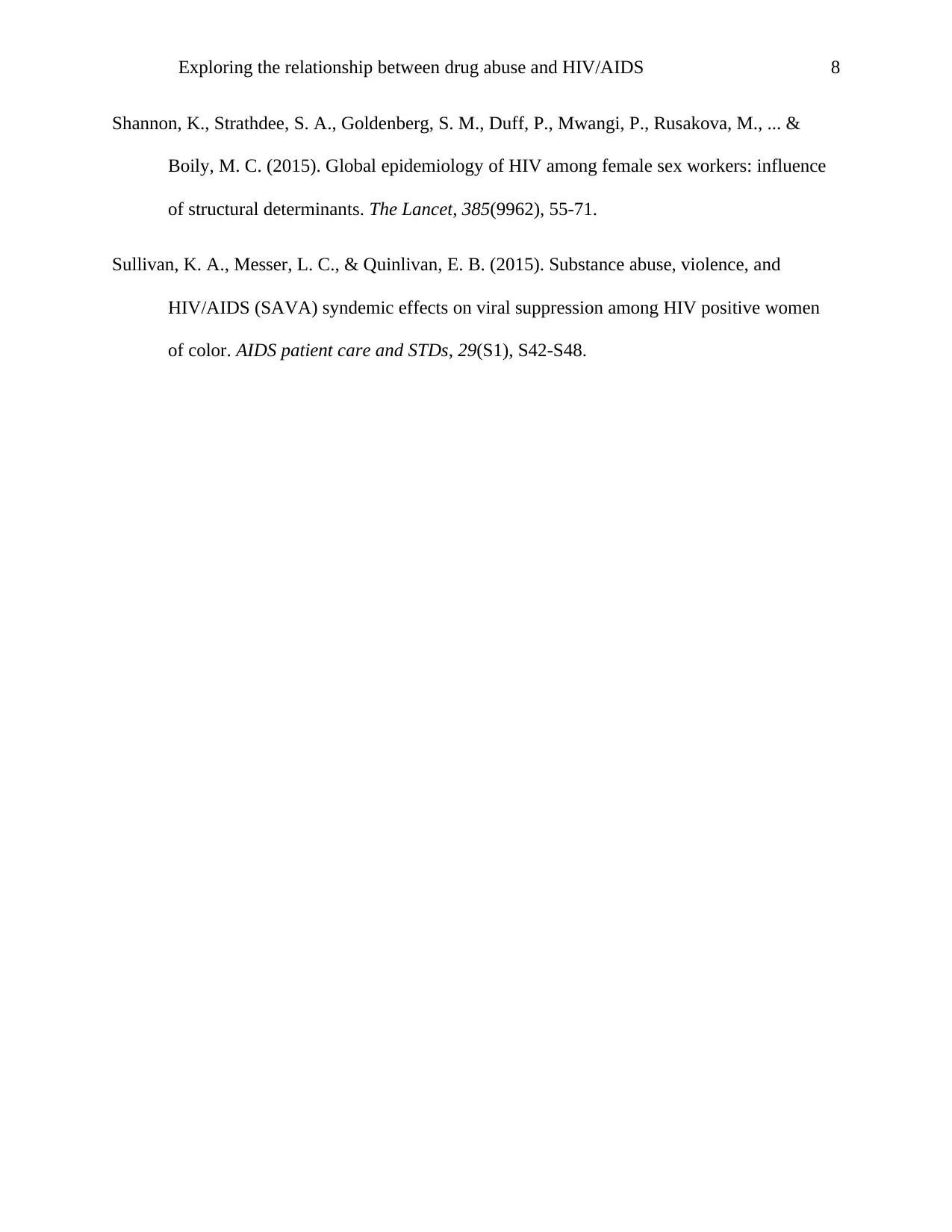
Exploring the relationship between drug abuse and HIV/AIDS 8
Shannon, K., Strathdee, S. A., Goldenberg, S. M., Duff, P., Mwangi, P., Rusakova, M., ... &
Boily, M. C. (2015). Global epidemiology of HIV among female sex workers: influence
of structural determinants. The Lancet, 385(9962), 55-71.
Sullivan, K. A., Messer, L. C., & Quinlivan, E. B. (2015). Substance abuse, violence, and
HIV/AIDS (SAVA) syndemic effects on viral suppression among HIV positive women
of color. AIDS patient care and STDs, 29(S1), S42-S48.
Shannon, K., Strathdee, S. A., Goldenberg, S. M., Duff, P., Mwangi, P., Rusakova, M., ... &
Boily, M. C. (2015). Global epidemiology of HIV among female sex workers: influence
of structural determinants. The Lancet, 385(9962), 55-71.
Sullivan, K. A., Messer, L. C., & Quinlivan, E. B. (2015). Substance abuse, violence, and
HIV/AIDS (SAVA) syndemic effects on viral suppression among HIV positive women
of color. AIDS patient care and STDs, 29(S1), S42-S48.
1 out of 8
Related Documents
Your All-in-One AI-Powered Toolkit for Academic Success.
+13062052269
info@desklib.com
Available 24*7 on WhatsApp / Email
![[object Object]](/_next/static/media/star-bottom.7253800d.svg)
Unlock your academic potential
Copyright © 2020–2025 A2Z Services. All Rights Reserved. Developed and managed by ZUCOL.





